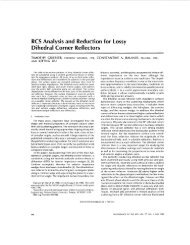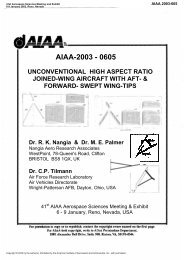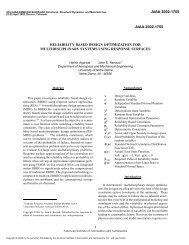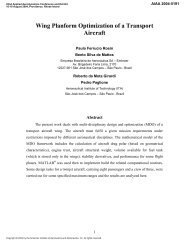The design report
The design report
The design report
You also want an ePaper? Increase the reach of your titles
YUMPU automatically turns print PDFs into web optimized ePapers that Google loves.
Flight test 2 6.2.2<br />
This flight test was conducted after adding 500 grams of payload. Some of the payload<br />
was in the form of the pod, which was attached for this stage of the test flight. As<br />
previously mentioned, the centre of gravity without payload was at 32% of the chord.<br />
<strong>The</strong> team had calculated that this could be moved to 25% if an additional 200g was<br />
added in front of the battery. However, the pilot suggested that the aircraft would attain<br />
greater stability if the centre of gravity remained at 32%. Thus rather than adding<br />
balancing weights, the extra payload was added in the pod, directly under the centre of<br />
gravity, so as not to change its position.<br />
iSpy was able to successfully perform while carrying half a kilogram of payload, and<br />
managed to take off, maneuver and land as successfully and well as in the first test flight.<br />
However the problem with the landing gear remained and the second takeoff was<br />
equally as shaky as the first, although the pilot managed to brilliantly overcome all<br />
obstacles and attain lift-off.<br />
Flight test 3 6.2.3<br />
<strong>The</strong> third test flight was more in keeping with the planes mission as a spy plane. <strong>The</strong><br />
payload was removed, and the camera taped to the wing again. <strong>The</strong>n the team<br />
instructed the pilot to fly as low as possible over the team so that they could appear on<br />
the video being taken by the spy camera. This was an important mission, as it is a<br />
critical attribute of a spy plane that it be able to fly low and conduct reconnaissance<br />
work.<br />
iSpy completed this mission stupendously well, and then spectacularly undertook a few<br />
more maneuvers before beginning descent. On this third and final descent, the pilot shut<br />
off the engines for landing, to test the gliding ability. iSpy rose splendidly to this final<br />
challenge and glided magnanimously to safety.<br />
Overall, these test flights can be viewed as an overwhelming success. On a basic level,<br />
ISpy was able to successfully taxi, takeoff, fly and land, and is still intact enough to be<br />
able to perform all these procedures again if necessary. All the control surfaces worked<br />
perfectly, and the plane proved to be fantastically well <strong>design</strong>ed and built, such that it<br />
was able to withstand the forces applied to it during flight. <strong>The</strong> exception to this is the<br />
malfunction of the landing gear, but even this was not too severe and did not drastically<br />
affect the performance of the plane. Despite its faults, the landing gear was able to<br />
withstand the forces applied to it during landing. <strong>The</strong> test flights also showed iSpy to<br />
have successfully achieved the aims set out in the <strong>design</strong> parameters, both those set by<br />
the professor, and those set by the team. Despite the shaky takeoff, the takeoff distance<br />
was not too great, and the plane was never in danger of overrunning the allotted<br />
distance. As well as this, iSpy was easily able to lift the 500 gram payload, and remain<br />
airborne for the <strong>design</strong>ated length of time. iSpy also fulfilled the mission set by the team,<br />
and showed itself to be capable of undertaking reconnaissance work. Overall the test<br />
flights were a marvelous success, and iSpy emerged triumphant.








![Introduction to RF Stealth [Book Review] - Antennas and ...](https://img.yumpu.com/16857890/1/190x245/introduction-to-rf-stealth-book-review-antennas-and-.jpg?quality=85)








